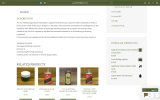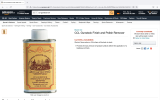rookhawk
AH ambassador
I just thought some of you might be interested in how to conserve (not restore, conserve) a used gun. Restorations focus on removing material and reapplying it, whereas conservation removes no original finish or condition, it only puts back what is missing.
Everyone should learn how to conserve their guns when acquired and therefore you’ll be able to maintain your guns ongoing through their useful life.
In this example, we found a dangerous game rifle for my son, a dakota model 76. The gun was not abused, but it has been used and carried on safaris so there is wear. We have no interest in rebluing the gun, nor do we want to strip off the finish, or use sandpaper, but we do want to take a gun in what appears 85% condition and bring it back to 95%-98% condition. You may ask “what’s the point, you’re taking it on safari and it will be back in 85% condition in no time”. Yes, that’s true, but the additional conservation will ensure that you can bring it back to 95% condition yet again, whereas using it in 85% condition will take it down to 80%, than 70% and eventually you will have a firearm that requires a full restoration to bring it back to condition. Restoration is evil, destructive, and removes things that can never be put back right again. (Like wood, or metal)
In this example, here is what we are doing.
1.) Wood has small dents, scratches, micro-scratches, and the pores are opening up which indicates oil finish is thinning. These photos are before and then mid-project. Another month’s work is required to put the finish back completely. It’s easy, 4-5 drops of oil, every other day, rubbed in until warm continues. The warmth and gentle friction backs out small dings. Small scratches get filled by the oils. Larger scratches gain color and blend in. Lastly, the pores close so you start to get that glassy finish. Final coat decides whether it will be a muted London satin finish or a shiny semi-gloss. When this is completely done, a couple coats of renaissance wax or bowling alley wax is applied for wear/UV/water resistance. Upon return from safari, mineral spirits will be rubbed on the stock to remove all the wax and the above process will repeat again. The faster you readdress dents with warm friction of rubbing on oil, the greater the dent will yield back to its original (un-dented) shape.
2.) The case color metal appeared quite worn. Untrue. The actual case colors had only lost 2% of their colors, but the 20%+ loss was the illusion of clear Laqueur finish having been scratched off. Violin finish is a specialty fast-drying lacquer that hardens when applied in a matter of a few minutes. Reapplying lacquer ensures case colors do not fade and that sweat/salt doesn’t erode them.
3.) The barrel was gilded with brass and copper that accumulated. A regimen of wipe out bore foam, copper solvents, kroil soaked JB bore paste, and many (50-200 passes) with a nylon brush over several sessions will remove the layers of copper/brass/lead/powder that have accumulated due to haphazard or single-solvent cleaning that could not budge the various debris.
4.) The last thing to address is the blueing. Yes, there has been finish loss from carry, but most wear observed is not actually bluing loss, it is bleed-through of oxidation through thinning bluing, or it is surface metal rubbed on top of the bluing by sling swivels and the like. Using 0000 Bronze wool and Kroil as a penetrating oil will excise foreign metal and rust without being hard enough to remove any original finish.
Doing all these things when you acquire a used gun, and then every time you return from a safari, will ensure that your guns do not erode over time. A gun carried 30 days a year and treated to such practices will still look 90% condition after a half century of use. 100 years later, the gun will endure its first full restoration of which the average gun can endure two in its lifetime before things start to get severely worn.
P.s. - Last 4 pictures are mid-conservation, the prior are all “before photos”.










Everyone should learn how to conserve their guns when acquired and therefore you’ll be able to maintain your guns ongoing through their useful life.
In this example, we found a dangerous game rifle for my son, a dakota model 76. The gun was not abused, but it has been used and carried on safaris so there is wear. We have no interest in rebluing the gun, nor do we want to strip off the finish, or use sandpaper, but we do want to take a gun in what appears 85% condition and bring it back to 95%-98% condition. You may ask “what’s the point, you’re taking it on safari and it will be back in 85% condition in no time”. Yes, that’s true, but the additional conservation will ensure that you can bring it back to 95% condition yet again, whereas using it in 85% condition will take it down to 80%, than 70% and eventually you will have a firearm that requires a full restoration to bring it back to condition. Restoration is evil, destructive, and removes things that can never be put back right again. (Like wood, or metal)
In this example, here is what we are doing.
1.) Wood has small dents, scratches, micro-scratches, and the pores are opening up which indicates oil finish is thinning. These photos are before and then mid-project. Another month’s work is required to put the finish back completely. It’s easy, 4-5 drops of oil, every other day, rubbed in until warm continues. The warmth and gentle friction backs out small dings. Small scratches get filled by the oils. Larger scratches gain color and blend in. Lastly, the pores close so you start to get that glassy finish. Final coat decides whether it will be a muted London satin finish or a shiny semi-gloss. When this is completely done, a couple coats of renaissance wax or bowling alley wax is applied for wear/UV/water resistance. Upon return from safari, mineral spirits will be rubbed on the stock to remove all the wax and the above process will repeat again. The faster you readdress dents with warm friction of rubbing on oil, the greater the dent will yield back to its original (un-dented) shape.
2.) The case color metal appeared quite worn. Untrue. The actual case colors had only lost 2% of their colors, but the 20%+ loss was the illusion of clear Laqueur finish having been scratched off. Violin finish is a specialty fast-drying lacquer that hardens when applied in a matter of a few minutes. Reapplying lacquer ensures case colors do not fade and that sweat/salt doesn’t erode them.
3.) The barrel was gilded with brass and copper that accumulated. A regimen of wipe out bore foam, copper solvents, kroil soaked JB bore paste, and many (50-200 passes) with a nylon brush over several sessions will remove the layers of copper/brass/lead/powder that have accumulated due to haphazard or single-solvent cleaning that could not budge the various debris.
4.) The last thing to address is the blueing. Yes, there has been finish loss from carry, but most wear observed is not actually bluing loss, it is bleed-through of oxidation through thinning bluing, or it is surface metal rubbed on top of the bluing by sling swivels and the like. Using 0000 Bronze wool and Kroil as a penetrating oil will excise foreign metal and rust without being hard enough to remove any original finish.
Doing all these things when you acquire a used gun, and then every time you return from a safari, will ensure that your guns do not erode over time. A gun carried 30 days a year and treated to such practices will still look 90% condition after a half century of use. 100 years later, the gun will endure its first full restoration of which the average gun can endure two in its lifetime before things start to get severely worn.
P.s. - Last 4 pictures are mid-conservation, the prior are all “before photos”.
Last edited by a moderator:




